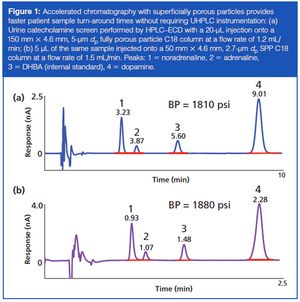
As clinical diagnostic assays move to LC–MS–MS, the emphasis has turned to emerging stationary phases that use alternative mechanisms of retention to separate the analyte–interference critical pairs.

As clinical diagnostic assays move to LC–MS–MS, the emphasis has turned to emerging stationary phases that use alternative mechanisms of retention to separate the analyte–interference critical pairs.

The last decade has seen a series of advances in the field of liquid chromatography that have resulted in improvements for many clinical diagnostic services. These innovations have included the expansion of superficially porous particle columns, new or improved stationary phase options, and “user-friendly” multiple-channel HPLC instrument options that allow sequential analysis-a boon for low and moderate throughput laboratories with limited hardware. As a result, diagnostic services are able to offer faster turn-around-times and measure analytes in patient types and disease states that were previously problematic. This article presents examples of the impact these innovations have had in a number of hospital settings.

Published: April 1st 2016 | Updated:

Published: May 18th 2016 | Updated: